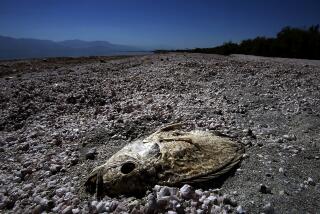Wetland Changes Brought Saltwater Bay to Garden
- Share via
GRAND CAILLOU, La. — Addie Authement tied his square-bowed work boat to a piling 150 yards out from the shore of Lake Boudreaux.
“Me and my boy stuck this piling here on dry ground when he was about 15 years old. He’s 34 now, and there’s about 5 feet of water here. We trawl for shrimp all around that piling,” Authement said.
The piling is painted red. A red reflector is fixed to its top. It used to mark the entrance to a narrow channel that Authement and his brother dug to get their pirogues to the lake.
“It was just wide enough to push-pole our pirogues, a little-bitty canal. Not even a canal, a ditch,” he said.
Parish Widened Canal
It became a canal about 20 years ago when Terrebonne Parish widened it to about 10 feet, installed a pumping station and began using it to drain rain water flooding into Lake Boudreaux.
The canal is 20 to 30 feet wide now and getting wider, its banks crumbling with every storm.
Salt water from the Gulf of Mexico killed groves of tall cypress trees and old oaks, leaving stark, dead stumps. Salt water also killed the marsh grass that fed muskrat and nutria.
A dank saltwater bay covers land that was a garden patch when Authement’s son was born.
“Who’d have told me 30 years ago that I’d be catching crabs there someday? I’d have told them they were lying,” Authement said. “The son of a gun stinks too.”
Much of the land loss became inevitable 50 years ago when the Corps of Engineers completed flood control projects on the Mississippi River. Levees trapped the river, robbing the marshes of fresh water and silt, and the spongy wetlands began contracting and sinking beneath the water.
Former High Ground
“That used to be a big coteau-- real high ground,” he said, pointing to an oak stump jutting out of the water, its trunk about 4 feet in diameter. “I used to shoot squirrels there.”
Authement and his wife celebrated their 45th wedding anniversary in April. In the early years of their marriage, they shelled shrimp for 12 1/2 cents an hour, shucked oysters for 50 cents a gallon, fished and sold sun-dried shrimp.
“It was hard, but it was a good life,” he said.
He blames the Houma Navigation Canal for most of the problems. Dredged to provide straight-line access from Houma shipyards to oil fields in the gulf, the canal also gives salt water access to the marshes.
“Forty years for all of this to go from fresh water to salt. I don’t believe we have 30 years left, unless somebody does something,” Authement said.
More to Read
Sign up for Essential California
The most important California stories and recommendations in your inbox every morning.
You may occasionally receive promotional content from the Los Angeles Times.










